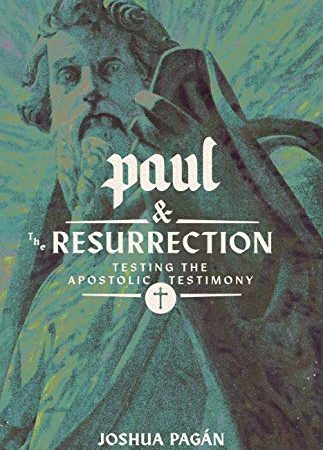Opponents of Christianity have formulated a variety of hypotheses to account for Paul’s experience on the Damascus Road.
Hesham Shehab: Paul and the Resurrection Testing the Apostolic Testimony – book review

Joshua Pagán
Published in 2020 by 1517 Publishing, Irvine, CA.
For the contemporary believer, Paul’s role in the historical setting of the Resurrection is far more than a matter of theological curiosity. The Christian justification for rational belief in the Resurrection is in large part anchored in Paul’s justification for rational belief in the authenticity of his own experience. In Paul we find the earliest and best attested documentary evidence for a historical investigation of the miraculous event. Moreover, his epistles are an indispensable source of independent corroboration of the gospel narratives.
Opponents of Christianity have formulated a variety of hypotheses to account for Paul’s experience on the Damascus Road. Some propose that Paul was deceptive; others argue that he was deluded; and still others contend he came to believe a legendary development. Yet according to the Christian hypothesis, Paul’s claim to have encountered the risen Jesus is dependable, and his testimony can be shown to withstand the scrutiny of critics. In this innovative, interdisciplinary study, Joshua Pagán combines the analytic tools of history and philosophy to explore and evaluate competing explanations of Paul’s belief in the Resurrection of Jesus.
Pagán was inspired by insights gained during his doctoral research. His dissertation was a project of analytic theology that explored the structure of Paul’s claim to knowledge of the Resurrection.
Among the more significant conclusions of the study was that the earliest testimonial evidence concerning the Resurrection is 1 Corinthians 15: 3- 8, and that these verses could be analyzed as a set of prepositions that feature positive interrelations.
In this book, Pagán applies this and other findings to argue that Paul strongly substantiates the case for the Resurrection, even in the face of conceivable challenges.
In the introduction, Pagán mentioned that the Christian understanding of the historical Resurrection of Christ is informed predominantly by Paul. But, why would Pagán focus on Paul, but leave out the disciples to whom Jesus appeared during the 40 days after His Resurrection?
Firstly, Paul’s narrative is generally non-controversial among specialists. Secondly, while Paul was almost certainly not present during the 40 days following the Resurrection, he nonetheless furnishes the primary source material of historical graphical analysis. In Paul’s writings, we find the earliest and best attested evidence for the claim that Jesus returned from the grave and his epistles provide independent corroboration of the gospel narratives.
Also, Paul was last among the apostles to witness the Risen Christ. The story of his own visionary experience is the most salient (Acts 9: 1- 9 26, Acts 26: 12 -32, 1Corinthians 15: 8, and Galatians 1: 11-24).
In addition, Paul gives us the primary basis of doctrinal formulation on the nature of the Resurrection of the body (1 Corinthians 15: 35- 58, 1 Thessalonians 4: 13- 18).
Finally, it is Paul who tells us that saving faith hinges on the historicity of the Easter miracle (1 Corinthians 15: 14). Paul assures us that it is His victory over death that justifies the believers hope for personal immortality.
But, is Christ’s Resurrection, as Paul analyzed it, plausible?
The central question in the book is: Was Paul deceptive, deluded, developed or dependable? Pagán says that regardless of their religious affiliation or philosophical persuasion, the vast majority of scholars agree that the belief in the Resurrection emerged suddenly and unexpectedly within the nascent Christian community, and that there was no Jewish tradition in 1st century Israel that could have been the basis for that belief. (p. 42)
Pagán proves, through argumentation, that Paul was neither deceptive, nor deluded, or developed, but dependable.
Paul suddenly and sincerely came to believe that he had encountered the risen Jesus. His radical departure from his native Judaism and adoption of this firm conviction is an essential component of the historical bedrock of the Resurrection narrative.
In conclusion, Pagán says that the Resurrection is a miracle that is based on the belief in God. So, in order to believe, we may say that God might or might not choose to act in the course of time by miraculous intervention. But, the evidence “demands that we believe Paul’s claim (…).” P.85
Reviewed by Hesham Shehab
============================
Joshua Pagán is the founder of The Institute of Intellectual Formation & Skeptical Inquiry and adjunct professor of Graduate Studies at Concordia Seminary, Fort Wayne, IN.
Read more news at XPian News… https://xpian.news

Hesham Shehab
Adjunct Faculty at College of DuPage, Formerly Adjunct Faculty at American University of Beirut and Pastor at Peace Lutheran Church Lombard, IL Name pronounciation: HI-shahm SHI-hab Hebrews 12: 4 & Philippians 1: 29




Comments are Closed